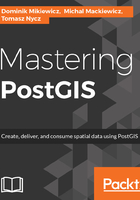
上QQ阅读APP看书,第一时间看更新
Importing MIF and TAB
Both MIF and TAB are MapInfo formats. TAB is the default format that contains formatting, while MIF is the interchange format.
We'll start with reviewing metadata:
ogrinfo EX_sample.mif
And then:
ogrinfo EX_sample.mif EX_Sample -so
Had to open data source read-only.
INFO: Open of `EX_sample.mif'
using driver `MapInfo File' successful.
Layer name: EX_sample
Geometry: Unknown (any)
Feature Count: 4142
Extent: (281282.800000, 85614.570000) - (300012.000000,
100272.000000)
Layer SRS WKT:
PROJCS["unnamed",
GEOGCS["unnamed",
DATUM["OSGB_1936",
SPHEROID["Airy 1930",6377563.396,299.3249646],
TOWGS84[375,-111,431,-0,-0,-0,0]],
PRIMEM["Greenwich",0],
UNIT["degree",0.0174532925199433]],
PROJECTION["Transverse_Mercator"],
PARAMETER["latitude_of_origin",49],
PARAMETER["central_meridian",-2],
PARAMETER["scale_factor",0.9996012717],
PARAMETER["false_easting",400000],
PARAMETER["false_northing",-100000],
UNIT["Meter",1]]
POSTCODE: String (8.0)
UPP: String (20.0)
PC_AREA: String (2.0)
Please note that ogrinfo projection metadata for our MIF file does not specify the EPSG code. This is fine, as the projection definition is present. But it will result in ogr2ogr creating a new entry in the spatial_ref_sys, which is not too good, as we'll end up with the wrong coordsys identifiers; the coordinate reference id will be the next available.
This is because ogr2ogr expands the coordinate reference into a WKT string and then does a string comparison against the coordsys identifiers definitions in the spatial_ref_sys table; minor differences in formatting or precision will result in ogr2ogr failing to match coordsys. In such a scenario, a new entry will be created; for example, if you happen to use the EPSG:3857 coordinate system and the system's definition is slightly different and cannot be matched, the assigned SRID will not be 3857, but the next available ID will be chosen.
A solution to this is to specify the exact coordinate system; ogr2ogr should output the data via the a_srs parameter.
This is because ogr2ogr expands the coordinate reference into a WKT string and then does a string comparison against the coordsys identifiers definitions in the spatial_ref_sys table; minor differences in formatting or precision will result in ogr2ogr failing to match coordsys. In such a scenario, a new entry will be created; for example, if you happen to use the EPSG:3857 coordinate system and the system's definition is slightly different and cannot be matched, the assigned SRID will not be 3857, but the next available ID will be chosen.
A solution to this is to specify the exact coordinate system; ogr2ogr should output the data via the a_srs parameter.
Once ready, we can import the data:
ogr2ogr -f "PostgreSQL" PG:"host=localhost port=5434 user=postgres dbname=mastering_postgis" EX_sample.mif -nln data_import.osgb_code_point_polygons_mif -lco GEOMETRY_NAME=geom -a_srs EPSG:27700
If you followed the very same procedure for TAB file and loaded the data, both datasets are now in their own tables in the data_import schema:
ogr2ogr -f "PostgreSQL" PG:"host=localhost port=5434 user=postgres dbname=mastering_postgis" EX_sample.tab -nln data_import.osgb_code_point_polygons_tab -lco GEOMETRY_NAME=geom -a_srs EPSG:27700